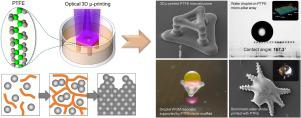Applied Materials Today ( IF 7.2 ) Pub Date : 2020-01-31 , DOI: 10.1016/j.apmt.2020.100580 Yangxi Zhang , Ming-Jie Yin , Xia Ouyang , A. Ping Zhang , Hwa-Yaw Tam

|
Polytetrafluoroethylene (PTFE) is a fluoropolymer well known for chemical inertness and insolubility, as well as the extreme hydrophobicity that can be achieved. Nonetheless, those unique properties make PTFE difficult to process, PTFE components are usually fabricated from the powder, and later shaped using traditional machining processes. So, although 3D printing can provide flexibility, fast and economically production of on-demand parts, especially complex 3D geometries that are hard or impossible to fabricate by machining processes, attempts to introduce PTFE into 3D printing are extremely rare and difficult. Here, we report a 3D micro-printing (μ-printing) method based on digital ultraviolet (UV) lithography for fabrication of micrometer-scale 3D PTFE structures and investigate their superhydrophobic properties and applications. In this method, PTFE nanoparticles are dispersed in a photocurable solution of polyethylene glycol diacrylate (PEGDA) and then 3D printed into predefined microstructures by layer-by-layer UV projection exposures. Subsequent sintering process removes other polymer with relatively low decomposition temperature to leave pure PTFE microstructure. In the experiments, 3D PTFE microscaffolds for droplet lasers and electrostatic-driven biomimetic water striders have been demonstrated to show the wide applications of the micro/nano-structured superhydrophobic PTFE surfaces as well as the flexible microengineering ability of the 3D μ-printing method.
中文翻译:

聚四氟乙烯微结构的3Dμ打印:通往超疏水表面和设备的途径
聚四氟乙烯(PTFE)是一种氟聚合物,因其化学惰性和不溶性以及可以实现的极高疏水性而闻名。但是,这些独特的性能使PTFE难以加工,PTFE组件通常由粉末制成,然后使用传统的机加工工艺成型。因此,尽管3D打印可以提供灵活性,快速且经济地生产按需零件,尤其是复杂的3D几何形状(很难或无法通过机械加工来制造),但是将PTFE引入3D打印的尝试却极为罕见且困难。在这里,我们报告了一种基于数字紫外线(UV)光刻技术的3D微打印(μ-print)方法,用于制造微米级3D PTFE结构,并研究了它们的超疏水性能和应用。在这种方法中,将PTFE纳米颗粒分散在聚乙二醇二丙烯酸酯(PEGDA)的光固化溶液中,然后通过逐层UV投影曝光将其3D打印到预定的微结构中。随后的烧结过程去除了分解温度相对较低的其他聚合物,从而留下了纯PTFE微观结构。在实验中,用于液滴激光的3D PTFE微支架和静电驱动仿生水water已被证明具有微米/纳米结构的超疏水PTFE表面的广泛应用以及3Dμ打印方法的灵活微工程能力。随后的烧结过程去除了分解温度相对较低的其他聚合物,从而留下了纯PTFE微观结构。在实验中,用于液滴激光的3D PTFE微支架和静电驱动仿生水water已被证明具有微米/纳米结构的超疏水PTFE表面的广泛应用以及3Dμ打印方法的灵活微工程能力。随后的烧结过程去除了分解温度相对较低的其他聚合物,从而留下了纯PTFE微观结构。在实验中,用于液滴激光的3D PTFE微支架和静电驱动仿生水water已被证明具有微米/纳米结构的超疏水PTFE表面的广泛应用以及3Dμ打印方法的灵活微工程能力。











































 京公网安备 11010802027423号
京公网安备 11010802027423号